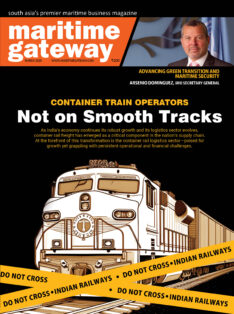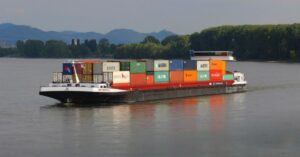“Not many people realize that 10% of the world’s sea bound trade is to and from India. Trade is going to pick up and we need a think tank to plan for infrastructure 20 years ahead,” shares Capt. Vivek Anand, Group CEO, MSA Global Logistics.
You have a very wide range of experience in container business, car carriers, energy transportation, and then your current portfolio seems to be more on the land side. So, I am curious to know how you are adapting to the shift in the operations and what is exciting for you now?
Well, sir, as they often say, one never stops to learn. So, having worked for large shipping companies, I was 23 years with Norwegian shipping company called Wilhelmsen and then about 19 to 20 years with NYK Line in India and having looked after purely shipping part of the business, I am now into the marine infrastructure or logistics infrastructure space as they say. So, yes, it’s a learning – it has been 44 years in the shipping and logistics industry, and yes there is a lot more. Frankly speaking, I haven’t met a single person in my career who knows it or who has done it all. So, it’s interesting, having worked for multinational companies, I am now able to apply my learnings with big companies and help India-centric business to grow, and the idea would be to first grow within India and then slowly try go global, if possible.
So, if we look at the commonality of both the sides of your professional career, container is one common thing that is in the plate, right. So, how do you see the global scenario of the containers and when you come to India, how do you see the container current market and what are your impressions for the next couple of quarters?
So, I think I have to break the question up into 2 to 3 parts. The first part is what is container trade? And I said this fairly often at different forums, container trade unlike what most people think is only 17% of the global trade, and in Indian seabound trade, it’s only 16%. So, there’s a lot more to shipping than just containers. That’s the first point. Now, going forward, we have seen a huge upswing just after Covid, the year 2021 – 2022 was very good. For all shipping companies and all businesses related to shipping and logistics. So, there was a huge upswing, something that was completely unprecedented but in hindsight today we can analyse and say why that upswing was there. But going forward, at this point in time, yes, the rates have crashed. Everybody is feeling the crunch. The market is at its pre-Covid lowest ebb and I don’t see a very drastic improvement. What I see is that yes, the season is just starting; September, October is the time when the season picks up for the trade, but till now there has not been a very significant change. What the pundits are saying is that in 2024, the global trade is going to rise about 3% or so. So, yes, next year should be better but I don’t think it will be anywhere close to the 2021 – 2022 levels, not in the near future for sure.
Most of your activities or rather the Group’s activities are linked with the landside infrastructure. So, how do you see the landside infrastructure coming up in India and where do you see the potential for the infrastructure part of it?
I see a huge scope for land infrastructure. What is the differentiation going to be? I think the differentiation going to be who can provide quality services, on-time services, people who have the cutting edge over the competition. Let me take the example of say, you want to set up a warehouse. If it’s going to be run of the mill warehouse, I don’t think you stand much of a chance but yes if you a state-of-the-art facility, you have good management and crew who can deliver on-time services. There is a new concept which started; earlier they used to call it Just-in-Time, but now it is Just-in-Sequence. So, there is going to be a combination of JIT and JIS, and people who are able to master that will definitely do well in the years to come, because India basically has a very huge scope. You see, India is a developing country. We are looking 5 trillion Dollars, but to be honest, I have seen figures and in fact, I am working on one presentation at this point in time which says by 2050, we will be almost 24 trillion Dollars; anything between 22 to 24 trillion Dollars, which is a very huge, four-folded…if you take the current 3.5 trillion as the base, we are almost talking about 7 to 8 times the current size of the economy. Everything, not only marine infrastructure, logistics infrastructure, all kind of manufacturing services in the service sector is going to flourish. I think it’s people who are geared, who have some years of experience behind and who can make the cutting-edge difference are the ones who are going to succeed.
You are also on several trade bodies. You have represented them, you have prepared white papers. So, if you look at a decade’s time, what has changed in the regulatory framework, whether it is on the Shipping Ministry side or on the Customs side and what still needs to be changed?
Firstly to start with, yes there has been a huge change. There has been a mindset change where people within the government or administration are thinking international. They are thinking quality, they are looking things from the consumers’ point of view, you know which is very positivebut on the other side, I have been a part of various committees and there is a lot which is talked about which is put on the paper, it’s documented but that shift, the speed of shift or change is not fast enough. We people, having worked for multinationals, it takes us time to decide because we have to gain consensus, we have to bring people over in whatever the objectives are being set for the company. But once we decide, then the implementation is spot on, bang on. Here, something is proposed, ten people will oppose it. Let me take a simple example – very recent. Five years ago I had a huge issue where I was proposing that Cabotage rule should be abolished and coastal shipping should be opened, and there was a hue and cry. But today we have come to the same cross-roads. Now, what was my thinking at that point in time. My thinking in the 90s… early 90s, India opened up to the world everybody said that we are selling the country to the world. Today, after 30 years, look where we are. We are just short of being a superpower. People are listening to us. Our population has become our strength. Our work force has become our strength. So, we have opened up, right. And we have seen the benefits and that is exactly what my thinking was 5 years ago and I reiterate that let us open up. Yes, you want to keep a certain share or a predominant share to Indian business people, no harm. But let the competition come in because that is where the efficiency and the quality could come, and who is the end gainer? It is the Indian public and the government.
Since you have brought up the topic of Cabotage relaxation, so what do you feel, will it really help in improving coastal shipping?
Yes, I feel it will but there are few things which have to be looked at. International shipping is a big game and the cost of international shipping calling India is the same as coastal shipping. For example, pilot cost or a tug boat. Whether it is a big ship or a small ship, the cost is more or less the same. I think somewhere, the administration will have to step in and take care of such things …the size of business, the size of capability must be taken into account when you levy the port charges to the coastal operators. So, yes, that will have to be looked into but a step in the right direction, let’s say.
Prime Minister has announced a big economic corridor connecting to the Europe through the Middle East. What will it bring in terms of benefit to the trade?
The India – Middle East – Europecorridor, it has been existing but not fully exploited. I think it is a step in the right direction and it should grow, especially, I would say India – Middle East sector which was started about 2 years ago. Some direct services have come in and with the agreement with the UAE, the trade has definitely improved between India and the Middle East. Further to Europe is a question, I think it is the infrastructure that will have to be coming first before that can be completely exploited to its fullest. The other corridor which you didn’t mention is the Eastern corridor which is coming up between Chennai and Russian ports of Vladivostokbut there I see a little of a problem to be honest. Most of the consumption in Russia is in the western parts of Russia. So, having an Eastern corridor, yes, it will probably give some advantages in trading with Southeast Asia, Interasiapartners because that is the biggest trade that India has but the cost of transportation from East Russia to West Russia firstly will increase the transit time and there is a huge rail cost…rail and/or road cost, the last mile connectivity. So, to be honest, I am in two minds, whether that will really take off and be a very powerful trade route in the years to come, but yes this does offer another alternative to people who are looking for solutions.
During post-Covid scenario, lot of experts felt that that situation will lead to a lot of near sourcing. Also, India will become an alternative like China Plus One theory. So, how do you look at India taking advantage and being a manufacturing hub?
Initially, 20 years ago, it used to be the big China story.Then it became China – India story. Then it became India – China story, and now I feel it’s India – India story. For big manufacturing bases to shift from China to India, it is not something that is going to happen in 6 months, 1 year, 2 years. It will take 5 to 7 to 10 years before that hub activities can be shifted and India becomes alternative. I see a tremendous amount of scope for India to grow both in imports and exports, and why is this happening? It is because of the economic stability of manufacturing countries. Logical strategic location of movement of goods at a faster pace and a lower cost and number 3 is there is a tremendous amount of support from the international community for India, whether it is on the business side or cultural side or any which way you want to take it, and so I see a huge growth. I would say if it’s not the golden era, it’s probably the golden period the next 15 to 20 years that Indians were to see. I think going forward, we will be no. 1 or no. 2 economy of the world, there is no doubt in my mind about it. USA and Europe…I have used this frame, it may sound a little rude but yeah, I think we need to stop flogging a dead horse. There is no growth, and just to share another interesting feature, by 2040, 73% of the world population will be living in the Asia-Pacific and Africa regions. So, even the consumption base, it’s not only going to be a manufacturing base but also a huge consumption base, which these countries in India, Far East, and Africa is going to provide to the rest of the world. So, yes, this is where the knowledge, man power, manufacturing is going to be or is being set up at this point of time, that’s the way I see it.
Let us talk a little bit of MSA Global. Now the group seems to be into almost all the verticals, into warehousing, freight forwarding, empty containers, container freight stations. So, can you give me an insight into each of these verticals, how the business is and what is the current business focus? Are there any expansion plans?
On the CFS front, we are having difficult time, and as you know most of the coastal areas have been declared as red zones so there is very limited flow. Also, with this DPD deliveries, and the market is today being controlled by CHAs, so, it is a tough call.There has been a price swap. I think we have shot ourselves in the foot but having said that, it is going to be tough going on the CFS route. Empty container depots, I think there is a huge growth possible over there because lot of imports are coming in and it will be requirement for state-of-the-art empty depots all over the country…so that’s a positive. Freight forwarding, a huge scope again. Domestic or bonded warehousing is a huge business and is going to continue growing. Here, I think on the warehousing side, there is one very interesting fact which I can share with you…..is the e-consolidators, people who are working inside warehouses and who have to actually take …let’s say, you wanted a pair of Adidas shoes, size 8. I order a pair of Nikes or something like that. Both have size 8. The e-consolidator is going to take out the Nike packet in Amazon packet and send it to me and the same e-consolidator going to take out the Adidas shoe and pack it in let’s say Flipkart or something of that sort and send it to you. Now, this market at this point in time, is 80% unorganized. Going forward, I think tables are going to turn. 80% will be organized and 20% will be unorganized. So, I think that’s a huge scope for logistics companies or the warehouse players to change the name of the game and that’s something one should look into going forward. So, warehousing has a huge scope; contract logistics with the manufacturing, that is going to happen or is happening within the country, is another huge scope. In general, I feel trade is going to pick up and I would share with you that not many people realize that the 10% of the world’s sea bound trade is to and from India. There are 186 countries in the world but 10% of the entire global trade is to and from India. We have 7500-kilometer coastline. I think we need to have a think tank set up and again, I have written a white paper on this topic many years back; we need to have a think tank to plan for what is going to be the scenario 20 years from now and prepare forit. We can’t firefight 20 years later.











